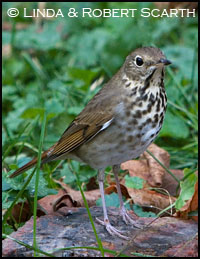introduction - galleries - technique - catalogue - notes - links - contact - blog - deep nature

Hermit Thrush
Sometimes we, like other birders and nature photographers, travel (even migrate with the seasons) to see particular bird or plant species. The sense of anticipation and pleasure is exhilarating. The rewards in observations, images and stories make the planning worthwhile. However, it can be as much, or even more fun, when the birds come to us. We especially look forward to the fall migrants who visit our small city garden. While travel can be an adventure, photographing from our enclosed back porch is easier and sometimes more productive, both for migrants and local resident birds. We see more residents while the migrants are coming through. Perhaps it is because we are looking out windows more often.
The highlight of this year?s late summer migration, to date, has been a female Golden-winged Warbler. She arrived one Sunday afternoon in late August when the shrubbery was full of resting and feeding American Redstarts. Not that they really sit still very long, even when taking a break in their migration. She moved about the yard working her way toward the ground level bird bath with its bubbler. Finally she perched on the edge and getting up her courage, lowered her head, took several quick drinks and melted back into the bushes. There was just time enough for a couple of clicks of the shutter release.
Much is written about bird feeding, gardening for birds and butterflies, and the use of water features to make backyards hospitable for creatures which may visit or even decide to co-habit with the human occupants. Libraries, bookstores, extension services, environmental organizations and garden clubs prepare literature and advice. The birds and insects already in the neighborhood are also good guides to what to use and how to arrange it. Tell your neighbors what you are doing and they also may make their gardens more bird friendly. When preparing a garden for wildlife, include the migrating birds in your plans and you will add another dimension to your birding and photography.
We have taken the approach that our whole yard should be inviting and offer food, shelter, water, a rest stop, and even a few nesting possibilities. Though small, we want it to be an oasis for birds and butterflies in a typical neighborhood with blue grass lawns, small flower beds and few shrubs. It is an older neighborhood so there are tall trees that provide homes for owls, crows, woodpeckers, even a kestrel family. The bonus for photographers is that a wildlife garden is an outdoor studio.
Each autumn we see several Hermit Thrushes come to drink and sometimes bathe. They come singly, creeping furtively under the highbush cranberry and through the ferns, sometimes flying up to low branches of shrubs. After a zigzag route through the garden they materialize at the birdbath. The one in this photo stood back a bit and got on tiptoes to see into the water before approaching.
We do not often see Northern Flickers in the summer but as fall approaches, they reappear to hunt ants in our chemical-free lawn, check out the fat feeder and have a drink. Cedar Waxwings come for the crabapples and bicker over the birdbath. Goldfinches spend their summers in rural fields and fence rows and come to town when the Purple Coneflowers in our front yard have gone to seed. On a recent evening we saw a begging juvenile in a tree trying to entice one of the adults flitting among the coneflowers to bring it some seed. One finally relented; popped some seed into the quivering waiting bill and quickly left. White-throated Sparrows come in to scratch about and pose among the fallen leaves and some remain into the winter, though most just travel further south.
Little gardens like ours are going to be needed more and more by migrating and resident birds as natural healthy habitats dwindle because of development. And not having to travel far to see and photograph some unusual species is like the proverbial bird in hand; something for which we are grateful. So is doing it from the comfort of a sheltered porch.
? Linda & Robert Scarth, 2006.
First published in NatureScape News, 1 (10), 6, 2006.
